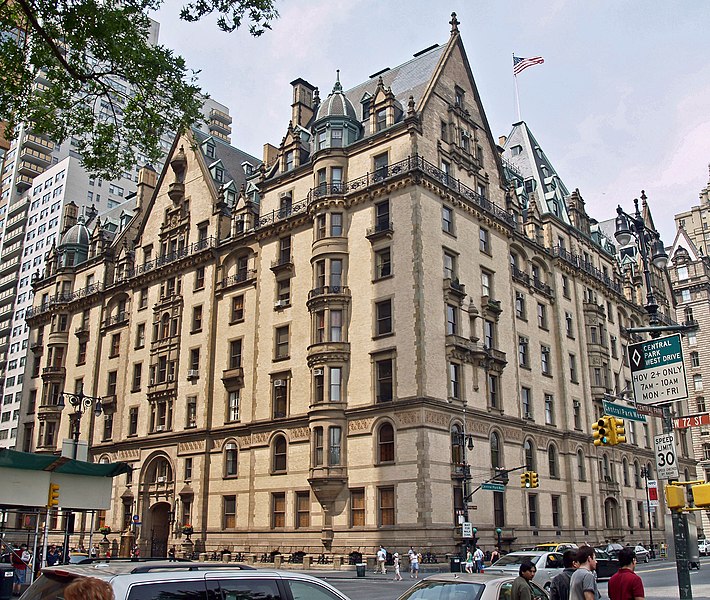Andrew Carnegie: a Scottish-American industrialist, businessman, entrepreneur and a major philanthropist.
Basic Schedule: Before the Concert: May 1st to May 4th, 1891
May 1st:
Arrive at New York City, and settle down and relax in your hotel room, which is at the Algonquin Hotel, a cozy hotel with red bricks and a limestone facade, located in the heart of Manhattan's most fashionable district. This hotel was built only recently, in 1890, and is a beautiful place that will give you ample space for both entertainment and relaxation.
May 2nd:
Visit The Dakota, a beautiful building with a touch of French architectural style. The Dakota is only a few miles off from your hotel, so you will be able to reach it in a very short time with the horse-drawn carriages we have provided. We have arranged for a special tour inside The Dakota, where you will be spending the majority of your day. For more information about the Dakota, look at the activities descriptions below.
May 3rd
On this day, you will go to the Central Park, a vast and scenic park that will take you away from the hustle and bustle of New York City. The central Part is very close to your living quarters, so you will once again take horse-drawn carriages. For more information, please look at the section called Activities Descriptions.
May 4th
On this day, you will visit the Columbus Circle, a majestic memorial depicting Christopher Columbus. When you visit, this memorial will still be in construction, but you will be able to see the monument in the middle depicting Columbus. This beautiful monument will allow you to experience a greater understanding of American history and ideals. The trip will be taken with a horse-drawn carriage, and please check the activities descriptions for more details.
May 5th:  The Day of the Concert:
You will spend the majority of the morning relaxing. In the afternoon, at around four o'clock, you are The Day of the Concert:
You will spend the majority of the morning relaxing. In the afternoon, at around four o'clock, you are
|
| tickets to the opening night concert |
advised to start preparing for the concert. If you want to, we will prepare for you some proper attire, allowing you to experience 19th century fashion. The concert will start at 4 o'clock, and end at around 10.
Concert Schedule:
Dedication Speech…………………………. Bishop Henry Codman Potter Leonore Overture No.3, Mozart…………… Damrosch & the Symphony Society Festival Coronation March………………… Tchaikovsky Berlioz’s Te Deum…………………………. Damrosch
Outside the Hall: Activities Descriptions
Carnegie Hall is not the only place worth looking at in New York City! Take a short trip around the Carnegie Hall, and take a look at these destinations!
Columbus Circle:
Take a trip the Columbus Circle, a major landmark named after Christopher Columbus, located in the Southwest Corner of Central park. In the 19th century, the Columbus Circle had yet to be completed, but you can still see the monument in the middle, which was erected in the1890s. This monument, created by the Italian sculptor Gaetano Russo, features a marble statue of Columbus atop a 70-foot granite column decorated with bronze reliefs of Columbus's ships. The pedestal features an angel with a globe in her
Central Park:
The building of the Central Park began around 1857, when New York City held a competition for the design of a new park. A plan called the "Greensward Plan" was chosen, and so construction began. The plan featured an English style landscape, with large meadows and numerous lakes and hills. During the creation of the Central Park, hundreds of thousands of trees were planted, a large reservoir was dug out, and 3 million cubic yards of soil were moved. Finally, 15 years after the start of building, the Central Park was completed. The Central Park is a great place for relaxation, and will help sooth your nerves and bring you away from the noise of the city. It's size also ensures that you won't get bored even after several days of exploring the park!
The Dakota
The Dakota, constructed from 1880-1884, is a beautiful building located in Manhattan, NYC. The Dakota is a square built around a central courtyard, with a porte cochere entrance large enough to fit horse-drawn carriages. During your visit here, you will also be able to ride in horse-drawn carriages. The building's architectural style is generally French, with its large courthouse and rooms arranged en filade. During your visit there, you will be able to visit a lot of these beautiful rooms, and experience for yourself the architectural style of the time.architectural style of the time.

|







